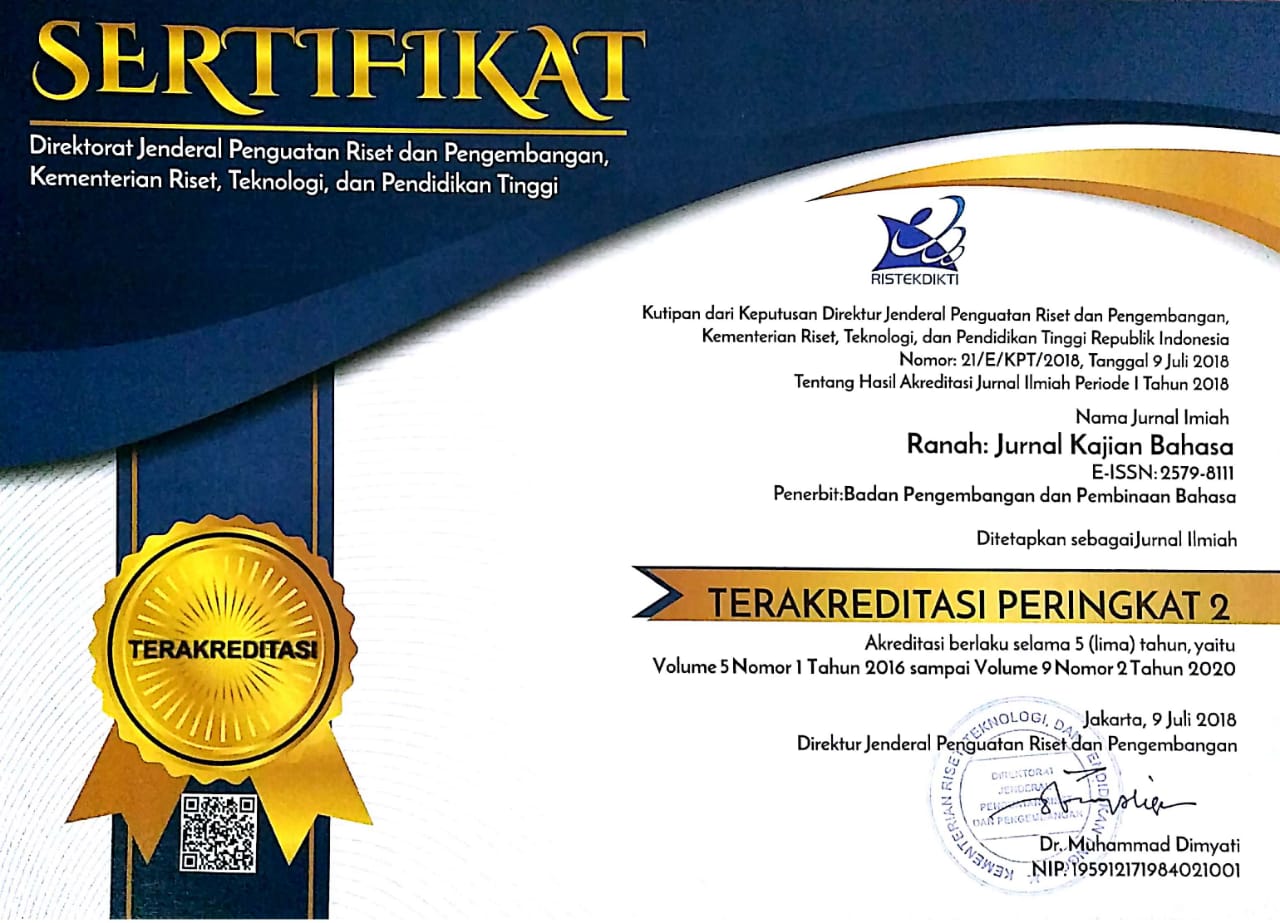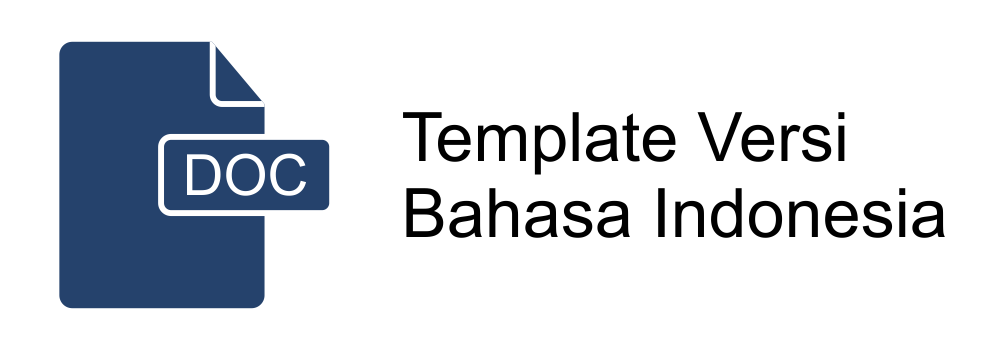Tuturan Bermakna Budaya sebagai Pembelajaran Kearifan Lokal Masyarakat Banjar: Studi Etnopedagogi
Abstract
This study discusses the form of Banjarese speech which contains a lexicon of local culture and local wisdom that can be taught behind the speech of cultural meaning. The purpose of the study is to describe the form of Banjarese speech which contains a lexicon of local culture and the form of local wisdom that can be taught behind the speech of cultural meaning. This study uses qualitative descriptive method with an ethnopedagogic approach. The research techniques are observation, documentation, and interviews. Data collection techniques are listening, recording, and getting involved in the research. The research steps are observation, data collection, data selection, presentation, analysis, and conclusions. The data source, speech that contains a lexicon with cultural meaning in the Banjar community, in Banjarmasin City, Banjar Regency, and Hulu Sungai Selatan. Data collection is from March 2021 to April 2022. Data validity is through triangulation of sources, theories, and methods. The study results that Banjarese speech that contains a lexicon of local cultural meanings include supporting parts for housing, livelihoods, literary arts, language, daily activities, and activities supporting equipment. The forms of local wisdom that can be taught behind these cultural speeches include creative, economic independence, politeness, entertainment and educative, health, hygiene, and adaptive. This finding shows that daily speech can be a source of learning local wisdom with cultural value for the Banjar community and others, both formal and non-formal, one of which is for local content material for students.
Abstrak
Penelitian ini membahas tentang wujud tuturan berbahasa Banjar yang memuat leksikon bermakna budaya lokal dan wujud kearifan lokal yang dapat diajarkan di balik tuturan bermakna budaya tersebut. Tujuan penelitian yaitu mendeskripsikan wujud tuturan lisan berbahasa Banjar yang memuat leksikon bermakna budaya lokal dan wujud kearifan lokal yang dapat diajarkan di balik tuturan bermakna budaya tersebut. Metode deskriptif kualitatif dengan pendekatan etnopedagogi. Teknik penelitian observasi, dokumentasi, dan wawancara. Teknik pengambilan data, antara lain simak, catat, dan libat. Langkah penelitian yang dilakukan, yaitu observasi, pengambilan data, pemilihan data, penyajian, analisis, dan simpulan. Sumber data, tuturan yang memuat leksikon bermakna budaya pada masyarakat Banjar, di Kota Banjarmasin, Kabupaten Banjar, dan Hulu Sungai Selatan. Waktu pengambilan data mulai dari bulan Maret 2021 sampai dengan April 2022. Validitas data melalui triangulasi sumber, teori, dan metode. Hasil penelitian, yaitu tuturan berbahasa Banjar yang memuat leksikon bermakna budaya lokal meliputi bagian pendukung tempat tinggal, mata pencaharian, seni sastra, bahasa, aktivitas keseharian, dan peralatan pendukung aktivitas. Adapun wujud kearifan lokal yang dapat diajarkan di balik tuturan bermakna budaya tersebut meliputi kreatif, mandiri ekonomi, kesantunan, hiburan, dan edukasi kesehatan, kebersihan, dan adaptif. Temuan ini menunjukkan bahwa tuturan sehari-hari dapat menjadi sumber pembelajaran kearifan lokal bernilai budaya bagi masyarakat Banjar dan lainnya, baik formal maupun nonformal, salah satunya untuk materi muatan lokal bagi anak didik.
Keywords
Full Text:
PDF (Bahasa Indonesia)References
Addi, Y. W., Zhang, Y., Ding, X. Y., Guo, C. A., & Wang, Y. H. (2022). A study of the plant folk nomenclature of the Yi people in Xiaoliangshan, Yunnan Province, China, and the implications for protecting biodiversity. Journal of Ethnobiology and Ethnomedicine, 18(1), 1-29. https://doi.org/10.1186/s13002-022-00504-0
Aflanie, I., Panghiyangan, R., Nurikhwan, P. W., Yudianto, A., & Koesbardiati, T. (2021). Analysis of genetic variations and specific locus of banjar hulu tribe through short tandem repeat (Str) locus combine dna index system (codis) in nuclear dna. Indian Journal of Forensic Medicine and Toxicology, 15(1), 1175-1180. https://doi.org/10.37506/ijfmt.v15i1.13577
Ageeva, V. A., Kolesnikova, M. E., Nechushkin, A. Y., Shchukina, E. L., Federation, R., Federation, R., Federation, R., & Federation, R. (2022). On the Issue of the Specifics of Cossack Education in the Russian Empire (on the Example of the Don Army). Bylye Gody, 17(1), 168-179. https://doi.org/10.13187/bg.2022.1.168
Alfita, L., Kadiyono, A. L., Nguyen, P. T., Firdaus, W., & Wekke, I. S. (2019). Educating the External Conditions in the Educational and Cultural Environment. International Journal of Higher Education, 8(8), 34-38.
Arnawa, N., Ariawati, N. W., Erawati, N. K. R., & Sulibra, I. K. N. (2022). Pragmalinguistics Politeness in the Balinese Language. Theory and Practice in Language Studies, 12(9), 1748-1755. https://doi.org/10.17507/tpls.1209.06
Asmara, R. (2016). Eksplorasi Fungsi dan Nilai Kearifan Lokal Dalam Tindak Tutur Melarang di Kalangan Penutur Bahasa Jawa Dialek Standar. Transformatika, 85(1), 2071-2079.
Azwar, S. (2016). Metode penelitian. Jogjakarta.Pustaka Pelajar.
Basu, A. (2021). Contexts and concerns for sustainability of cultural heritage sites of Bishnupur. Plural. History. Culture. Society, 8(2), 120-130. https://doi.org/10.37710/plural.v8i2_11
Basu, A., & De, A. (2021). Heritage valuation driving sustainability of cultural capital in bishnupur in eastern india. Plural. History. Culture. Society, 9(1), 103-115. https://doi.org/10.37710/plural.v9i1S_7
Cao, Y., Li, R., Zhou, S., Song, L., Quan, R., & Hu, H. (2020). Ethnobotanical study on wild edible plants used by three trans-boundary ethnic groups in Jiangcheng County, Pu'er, Southwest China. Journal of Ethnobiology and Ethnomedicine, 16(1), 1-23. https://doi.org/10.1186/s13002-020-00420-1
Davis, A. E., Gamble, R., Roche, G., & Gawne, L. (2021). International relations and the Himalaya: connecting ecologies, cultures and geopolitics. Australian Journal of International Affairs, 75(1), 15-35. https://doi.org/10.1080/10357718.2020.1787333
Dewi, I. S., Hastuti, U. S., Lestari, U., & Suwono, H. (2020). Local wisdom and laboratory experiment-based extension booklet development for wadi makers of elementary-educated and dropout society in central kalimantan. Jurnal Pendidikan IPA Indonesia, 9(4), 611-619. https://doi.org/10.15294/jpii.v9i4.23166
Fakhiroh, N. Z., Suprijono, A., & M, J. (2020). Etnopedagogi Kesenian Reog Cemandi untuk Penguatan Pendidikan Karakter Bangsa Peserta Didik Kelas V Sekolah Dasar. Jurnal Education and Development, 8(3), 231-236.
Fatimah, D. (2010). Metode Linguistik; Ancangan Metode Penelitian dan Kajian. Jakarta. PT Eresco.
Furqon. (2015). Etnopaedagogi: Pendekatan Pendidikan berbudaya dan membudayakan. Ethnopedagogy, The Prceeding of International Sminar on Etnopedagogy. Banjarmasin.Universitas Lambung Mangkurat.
Gazzola, M., & Templin, T. (2022). Language Competition and Language Shift in Friuli-Venezia Giulia: Projection and Trajectory for the Number of Friulian Speakers to 2050. Sustainability (Switzerland), 14(6).2--18. https://doi.org/10.3390/su14063319
Gong, Y. F., Ma, M., Hsiang, T. P., & Wang, C. (2020). Sustaining international students' learning of Chinese in China: Shifting motivations among New Zealand students during study abroad. Sustainability (Switzerland), 12(15).2--14. https://doi.org/10.3390/su12156289
Hamdani, D. (2017). Kearifan Lokal - Pendidikan Budaya - Etnopedagogik.Bandung. Alpabeta Bandung.
Norvia. (2020). Refleksi Budaya Lampau Leksikon Kebendaan Peribahasa Banjar: Kajian Etnolinguistik. UNDAS: Jurnal Hasil Penelitian Bahasa dan Sastra, 16(1), 93-106. https://doi.org/10.26499/und.v16i1.2176
Humaidi, A. (2016). Nilai Budaya dalam Lirik Lagu Banjar Karya Syarifudin MS. Pelataran Seni, 1(1), 71--80. https://doi.org/10.20527/jps.v1i1.1454
Indriyani, P. D. (2022). Nilai-Nilai Religius Dalam Kesenian Tradisional Masyarakat Banjar. Indonesian Journal of Performing Arts Education, 1(1), 33-41. https://doi.org/10.24821/ijopaed.v1i2.5342
Istiqomah, Ermina., & Setyobudihono, S. (2019). Nilai budaya masyarakat banjar kalimantan selatan: studi indigenous ermina. Journal of Chemical Information and Modeling, 53(9), 1-6.
Karlsson, A., Nygård Larsson, P., & Jakobsson, A. (2019). Multilingual students' use of translanguaging in science classrooms. International Journal of Science Education, 41(15), 2049-2069. https://doi.org/10.1080/09500693.2018.1477261
Kim, D. (2020). Learning Language, Learning Culture: Teaching Language to the Whole Student. ECNU Review of Education, 3(3), 519-541. https://doi.org/10.1177/2096531120936693
Kline, M. A., Shamsudheen, R., & Broesch, T. (2018). Variation is the universal: Making cultural evolution work in developmental psychology. Philosophical Transactions of the Royal Society B: Biological Sciences, 373(1743).1--8. https://doi.org/10.1098/rstb.2017.0059
Koentjaraningrat. (2014). Pengantar Antropologi. Rineka Cipta. https://doi.org/10.7454/ai.v0i47.3271
Lumempouw, F., Rambing, R. R., & Mantiri, E. (2021). Lexicon symbolic meaning in building houses tradition on building materials selection as local wisdom in Minahasa Tombulu area. Linguistics and Culture Review, 5(S4), 1500-1507. https://doi.org/10.21744/lingcure.v5nS4.1885
Maharani, A. V. (2019). Pemerolehan Kosakata Bahasa Korea pada Pembelajar Dewasa Indonesia. Ranah: Jurnal Kajian Bahasa, 8(2), 255--266. https://doi.org/10.26499/rnh.v8i2.962
Mahdayeni, M., Alhaddad, M. R., & Saleh, A. S. (2019). Manusia dan Kebudayaan (Manusia dan Sejarah Kebudayaan, Manusia dalam Keanekaragaman Budaya dan Peradaban, Manusia dan Sumber Penghidupan). Tadbir: Jurnal Manajemen Pendidikan Islam, 7(2), 154-165. https://doi.org/10.30603/tjmpi.v7i2.1125
Mansyhuri, Z. (2008). Metodologi Penelitian. Refika Aditama.
Menon, M. (2021). Indigenous knowledges and colonial sciences in South Asia. South Asian History and Culture, 13(1), 1-18. https://doi.org/10.1080/19472498.2021.2001198
Mujiburrahman. (2017). Historical dynamics of inter-religious relations in South Kalimantan. Journal of Indonesian Islam, 11(1), 145-174. https://doi.org/10.15642/JIIS.2017.11.1.145-174
Muzakkir. (2014). Pendekatan Etnopedagogi Sebagai Media Pelestarian Kearifan Lokal. English Review: Journal of English Education, 2(2), 124-132. https://www.academicareview.com/index.php/jh/article/view/16
Okeke, G. T., & Okeke, C. O. (2022). On the semantic-pragmatic interface of Igbo verbs of perception. Cogent Arts and Humanities, 9(1) 15-32. https://doi.org/10.1080/23311983.2022.2025991
Oktavianti, I., & Ratnasari, Y. (2018). Etnopedagogi Dalam Pembelajaran Di Sekolah Dasar Melalui Media Berbasis Kearifan Lokal. Refleksi Edukatika : Jurnal Ilmiah Kependidikan, 8(2).149-154. https://doi.org/10.24176/re.v8i2.23533
Panji Tresna, I. G. N. A., Kenia Naras Sauca, & Niluh Putu Pebriyanti. (2022). Kajian Etnopedagogi Pada Kain Idup Panak Di Desa Tenganan Pegringsingan, Karangasem-Bali. Guna Widya: Jurnal Pendidikan Hindu, 9(1), 23-30. https://doi.org/10.25078/gw.v9i1.307
Paramita, P. P., & Tata, H. L. (2021). Phytochemical compounds identification of three bajakah species (Salacia sp., Uncaria acida, and Uncaria gambir) using GC-MS pyrolysis. IOP Conference Series: Earth and Environmental Science, 762(1). 1--12. https://doi.org/10.1088/1755-1315/762/1/012043
Parhani, I., & Fakultas. (2016). Perubahan Nilai Budaya Urang Banjar (dalam Perspektif Teori Troompenaar)1 Imadduddin. AL BANJARI, 15(1), 390-392. https://doi.org/10.18592/al-banjari.v15i1.861
Perangin-Angin, D. M., & Dewi, N. (2020). Merawat Lagu-lagu Daerah Pagu untuk Pemertahanan Bahasa: Analisis Ekolinguistik. Ranah: Jurnal Kajian Bahasa, 9(2), 272-286. https://doi.org/10.26499/rnh.v9i2.2932
Putra, P. (2017). Pendekatan Etnopedagogi dalam Pembelajaran IPA SD / MI. Primary Education Journal (PEJ), 1(1), 17-23.
Sarkar, A., & Mistri, B. (2017). Home environment as strong determinant in academic involvement of female students in Dhekia Gram Panchayat of Saltora C.D. Block, Bankura District. Space and Culture, India, 5(2), 97-116. https://doi.org/10.20896/saci.v5i2.268
Singh, C. (2021). Science in the vernacular? Translation, terminology and lexicography in the Hindi Scientific Glossary (1906). South Asian History and Culture, 13(1), 63-86. https://doi.org/10.1080/19472498-.2021.2001200
Slobodová Nováková, K., Sirotová, M., Urban, M., & Boghana, J. (2021). Using The Elements Of Traditional Culture In The Teaching Process From The Perspective Of Ethnopedagogy And Ethnology. Journal of Education Culture and Society, 12(2), 495-504. https://doi.org/10.15503/jecs2021.2.495.504
Sudiana, I. K. (1990). Peluang Kreativitas Pertunjukan Wayang Kulit Bali dalam Revolusi Industri 4.0. Proseding seminar Nasional Seni Pertunjukan Nusantara Peluang dan Tantangan Memasuki Era Revolusi 4.0. 91-96. Denpasar.Fakultas Seni Pertunjukan.Institut Seni Indonesia Denpasar.
Sujinah, S., Mu'ammar, M. A., Affandy, A. N., & Supriyanto, E. (2019). The effectiveness of local wisdom based on textbook to improve students' writing literacy. Universal Journal of Educational Research, 7(12), 2573-2583. https://doi.org/10.13189/ujer.2019.071204
Sulistyono, Y., & Fernandez, I. Y. (2019). Linguistic situation around east flores and Alor-Pantar islands in east Indonesia. Humanities and Social Sciences Reviews, 7(3), 189-194. https://doi.org/10.18510/hssr-.2019.7329
Suyitno, I. (2012). the Development of Education on the Character and Culture of. Jurnal Pendidikan Karakter, 2(February 2012), 1-13.
Syamsi, I., & Tahar, M. M. (2021). Local wisdom-based character education for special needs students in inclusive elementary schools. Cypriot Journal of Educational Sciences, 16(6), 3329-3342. https://doi.org/10.18844/cjes.v16i6.6567
Wahyu. (2015). Pendidikan IPS berbasis Kearifan Lokal. Banjarmasin. Program Studi Pendidikan IPS. Jurusan Pendidikan IPS FKIP Unlam.Universitas Lambung Mangkurat. Wahana Jaya .
Wati, M., & Misbah, M. (2021). The content validity of the assessment instrument on the characters of wasaka in wetland environment physics learning. Journal of Physics: Conference Series. 1760(1).1--7. https://doi.org/10.1088/1742-6596/1760/1/012016
Weng, J. (2020). End of an Era: Transforming Language and Society in Japan, Korea, and Vietnam, c. 1870-1950. Archives Europeennes de Sociologie, 61(2), 269-299. https://doi.org/10.1017/S0003975620000120
Widana, I. N. A., & Dwijayanthi, N. M. A. (2021). Ngaasin Sebagai Pendidikan Karakter: Kajian Etnopedagogi.Subasita: Jurnal Sastra Agama dan Pendidikan Bahasa Bali, 2(2),1-10. http://www.jurnal.stahnmpukuturan.ac.id/index.php/subasita/article/view/1761
Wooltorton, S., Guenther, J., Poelina, A., Blaise, M., Collard, L., & White, P. (2022). Learning regenerative cultures: Indigenous nations in higher education renewal in Australia. Asia Pacific Education Review, September (2022).1-13. https://doi.org/10.1007/s12564-022-09789-y
Yanti, N.dan Fina Hiasa (2021). Implementasi Kesantunan Berbahasa Pedagang Ikan Di Kawasan Pesisir Kota Bengkulu. Ranah Jurnal Kajian Bahasa. 10(1), 73-85. https://doi.org/10.26499/rnh.v10i1.983
Yuningsih, E. (2022). Mengungkap Makna Simbolik dalam Khazanah Leksikon Etnoarsitektur Hijau Keraton (Kajian Etnolinguistik di Keraton Kasepuhan Cirebon). Ranah: Jurnal Kajian Bahasa, 11(1), 64-75. https://doi.org/10.26499/rnh.v11i1.4495
Zakaria, Z. (2020). Etnopedagogi Tradisi Palang Pintu Pada Etnis Betawi Sebagai Bentuk Pembelajaran Literasi Dini. Dirasah: Jurnal Pemikiran dan Pendidikan 3(Februari).20-33. https://stai-binamadani.e-journal.id/jurdir/article/view/147
Zohrah, L., & Handjayanti, S. (2021). Conservation of tropical peatlands and regeneration of Banjarese urban areas: A case study of town planning in the Central and South Kalimantan. IOP Conference Series: Earth and Environmental Science, 780(1). https://doi.org/10.1088/1755-1315/780/1/012073
Карданова, Б. Б., Телепень, С. В., & Зинеева, З. З. (2021). Nogai ethnopedagogy: types, means and methods of education. Al'manah «Etnodialogi», 1(63), 178-189. https://doi.org/10.37492/ETNO.2021.64.1.012
DOI: https://doi.org/10.26499/rnh.v11i2.5196
Refbacks
- There are currently no refbacks.








